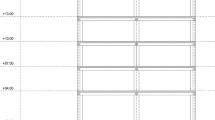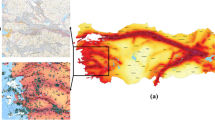Abstract
The fundamental period has a primary role in seismic design and assessment as it is the main feature of the structure that allows one to determine the elastic demand and, indirectly, the required inelastic performance in static procedures. In fact, the definition of easy to manage relationships for the assessment of the elastic period has been the subject of a significant deal of both experimental and numerical/analytical studies, some of which have been acknowledged by codes and guidelines worldwide. Moreover, this kind of information is useful for territorial-scale seismic loss assessment methodologies. In the majority of cases, the assessment of the period is considered as function of the structural system classification and number of storeys or height. Reinforced concrete structures, comprising most of the building stock in Italy and in seismic prone areas in Europe and in the Mediterranean region, were built after the Second World War and are designed with obsolete seismic codes, if not for gravity loads only. Therefore, a class of buildings featuring the same height and/or number of storeys may show a significant variability of the structural system. This, along with the contribution of the stair module, may affect the elastic periods in the two main directions of a three-dimensional building. In the study presented these issues are investigated with reference to a population of existing RC structures designed acknowledging the practice at the time of supposed construction (e.g., simulated design) and with reference to the relative enforced code. The elastic period is evaluated for both main directions of the buildings of the considered sample, and regression analysis is employed to capture the dependency of the elastic dynamic properties of the structures as a function of mass and stiffness.
Similar content being viewed by others
References
Applied Technological Council (1978) Tentative provisions for the development of seismic regulation for buildings. Rep. No, ATC3-06, Applied Technological Council, Palo Alto
Bal IE, Crowley H, Pinho R, Gulay FG (2007) Structural characteristics Of Turkish RC building stock in northern Marmara region for loss assessment applications. IUSS Press, Pavia
CEN (2004) Eurocode 2: design of concrete structures—part 1–1: general rules and rules for buildings. European Prestandard ENV 1992-1-1. Comite European de Normalisation, Brussels
CEN (2005) Eurocode 8: design provisions for earthquake of structures—part 1–4: strengthening and repair of buildings. European Prestandard ENV 1998-1-4. Comite European de Normalisation, Brussels
Chopra AK (1995) Dynamics of structures: theory and applications to earthquake engineering. Pretince-Hall, Upper Saddle River
Cosenza E, Manfredi G, Verderame GM (2002) Seismic assessment of gravity loads designed r.c. frames: critical issues in structural modeling. J Earthq Eng 6(1): 101–122
Crowley H, Pinho R (2004) Period-height relationship for existing European reinforced concrete buildings. J Earthq Eng 8(1): 93–119
Crowley H, Pinho R (2009) Revisiting Eurocode 8 formulae for periods of vibration and their employment in linear seismic analysis. Earthq Eng Struct Dyn. doi:10.1002/eqe.949 (in press)
D.M. n 1684 (1975) Approvazione delle norme tecniche per le costruzioni in zone sismiche (in italian)
Goel RK, Chopra AK (1997) Period formulas for moment-resisting frame buildings. Struct Eng Div ASCE 123: 1454–1461
Hong L, Hwang W (2000) Empirical formula for fundamental vibration periods of reinforced concrete buildings in Taiwan. Earthq Eng Struct Dyn 29: 327–333
Legge n 1684 (1962) Provvedimenti per l’edilizia, con particolari prescrizioni per le zone sismiche (in Italian)
NEHRP: (1994) Recommended provisions for the development of seismic regulations for new buildings. Building Seismic Safety Council, Washington, DC
R.D.L. n 2105 (1937) Norme tecniche di edilizia con speciali prescrizioni per le località colpite dai terremoti (in Italian)
R.D.L. n 640 (1935) Norme tecniche di edilizia con speciali prescrizioni per le località colpite dai terremoti (in Italian)
R.D.L. n 2229 (1939) Norme per la esecuzione delle opere in conglomerate cementizio semplice od armato (in Italian)
SEAOC: (1996) Recommended lateral force requirements and commentary. Seismological Engineers Association of California, San Francisco
UBC-Uniform Building Code: (1997) International conference of building officials. Whittier, CA
Verderame GM, Polese M, Mariniello C, Manfredi G (2010) A simulated design procedure for the assessment of seismic capacity of existing RC buildings. Adv Eng Softw 41(2): 323–335
Verderame GM, Polese M, Cosenza E (2009) Vulnerability of existing RC buildings under gravity loads: A simplified approach for non sway structures. Eng Struct 31(9): 2141–2151
Author information
Authors and Affiliations
Corresponding author
Rights and permissions
About this article
Cite this article
Verderame, G.M., Iervolino, I. & Manfredi, G. Elastic period of sub-standard reinforced concrete moment resisting frame buildings. Bull Earthquake Eng 8, 955–972 (2010). https://doi.org/10.1007/s10518-010-9176-8
Received:
Accepted:
Published:
Issue Date:
DOI: https://doi.org/10.1007/s10518-010-9176-8




